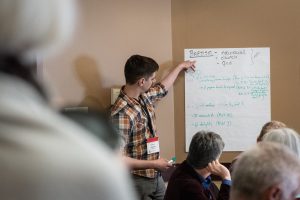Article 8
NFLT seeks feedback on draft revision of Article 8
 “Baptism is a gift from God and possibly the singular highlight in the life of a local church,” says National Faith and Life Team (NFLT) director Ingrid Reichard.
“Baptism is a gift from God and possibly the singular highlight in the life of a local church,” says National Faith and Life Team (NFLT) director Ingrid Reichard.
After a year of soliciting questions from churches through online surveys and 2019 provincial MB convention workshops, the NFLT has drafted a revision of Article 8 of the Canadian MB church’s Confession of Faith on “Christian Baptism.”
The two main concerns the NFLT heard revolved around 1) the link between baptism and participation in the church and 2) the requirement of rebaptism for those who were baptized as infants.
As they considered the rewrite, the team wanted a tone that is more invitational and joyful, says Reichard, and “that highlights God’s and the local church’s agency in baptism.”
From membership to family welcome
 At a NFLT Summit in May 2019, the team searched through Scripture and could find little evidence of a separation between baptism and church involvement in the New Testament church.
At a NFLT Summit in May 2019, the team searched through Scripture and could find little evidence of a separation between baptism and church involvement in the New Testament church.
Although pre-baptism preparation and post-baptism mentorship will differ from congregation to congregation, “We discourage churches from a process which disconnects participation, belonging, and discipleship from salvation and baptism,” says Reichard.
The larger question, says NFLT member Ken Esau, is why are baptismal candidates and churches desiring to separate these horizons? “If new believers are hesitant about joining the local church family, what does that say about how the church has been functioning as a family?”
“Inviting people to baptism is firstly God’s work through the Holy Spirit. The church encourages people to listen to the Spirit,” but, says Esau, “the church’s primary role is to recognize that divine invitation and joyfully respond to it.”
Addressing the concern that the previous confession’s “receive into membership” sounded too cold and institutional, the revision uses the language of “celebrating what God has done in a person’s life and their welcome into the church family,” says Esau.
“Baptism is both a looking back to conversion, faith, and the Holy Spirit’s coming and a looking forward to life as part of the new community centred on Jesus,” says Esau. “Any description of baptism’s meaning must do justice to both.”
A choice to testify
On the question of infant baptism, the team agreed that Mennonite Brethren still understand baptism as “chosen by a believer to testify to what has already happened to them and to demonstrate commitment to an ongoing life of discipleship and mission in the family.”
Therefore, it is not something “done to them by others which they later can choose to embrace or ignore,” says Esau. “We realize that walking with people in such cases takes much pastoral time, care, and teaching,” says Reichard. “We are working on resources to help with this task” including a new pastoral application to the confession in a convenient question and answer format.
“God is mysteriously and powerfully involved in baptism,” say Esau, but sign, symbol, and sacrament are not used for baptism in Scripture, so the draft revision prefers testify. “Baptism is not simply about a person’s emotional experience, but rather a rich community event that reflects the testimony of God, the person, and the local church.”
God was at work in the NFLT’s conversations, says Esau. “While there were moments of disagreement, it often felt
like Acts 15: ‘it seemed good to the Holy Spirit and to us.’” But, he says, “the real test is whether we live out our calling to make disciples, baptizing them, and teaching them to obey everything Jesus commanded us (Matthew 28:18–20).”
“Our hope is that this revision encourages that mission,” says Reichard.